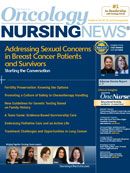Fertility Preservation-How Well Informed Are You?
Healthcare providers are expected to advise patients about the potential effects of cancer treatment, including impact on fertility. In many facilities, it's a required component of the informed consent process.
Lisa Schulmeister, RN, MN, APRN-BC, OCN®, FAAN
Editor-in-Chief OncLive Nursing
Oncology Nursing Consultant, Adjunct Assistant Professor of Nursing Louisiana State Health Sciences Center in New Orleans, Louisiana
Healthcare providers are expected to advise patients about the potential effects of cancer treatment, including impact on fertility. In many facilities, it’s a required component of the informed consent process. In reality, fertility effects take a back seat to the patient’s concern about treatment outcomes and life expectancy and the clinician’s desire to cover all possible side effects. Consequently, discussions about fertility—and especially fertility preservation options—often are brief and superficial, and outdated information is sometimes presented.
Keeping up with new oncology drugs and treatments is quite a challenge, and staying abreast of advances in fertility preservation is even more challenging. Fortunately, resources and guidelines have been developed to assist clinicians in providing the most current and most accurate information about fertility effects and fertility preservation to our patients.
One of these resources is a Clinical Practice Guideline developed by the American Society of Clinical Oncology (ASCO), available at www.asco.org/guidelines/ fertility. Key recommendations include discussing fertility effects and preservation with all patients of reproductive age and with parents/guardians of children and adolescents. Fertility preservation should be addressed as early as possible, ideally before treatment starts, and patients who express an interest in fertility preservation, as well as those who are ambivalent, should be referred to reproductive specialists. The ASCO Guideline also contains evidence-based information about fertility preservation. Sperm cryopreservation (sperm banking) is the only established fertility preservation method for males, and embryo and oocyte cryopreservation are the established preservation methods for females. Hormonal therapy should not be recommended for men as it does not preserve fertility, and there is insufficient evidence to support ovarian suppression as a fertility preservation measure.
Established methods of fertility preservation (sperm and oocyte cryopreservation) are recommended for use in postpubertal adolescents.
ASCO and the LIVESTRONG Foundation produced “Moving Forward” videos specifically focusing on fertility, with one targeted to teens and another for young adults. These are accessible online at both organizations’ websites.
Fertile Hope, www.fertilehope.org, is a LIVESTRONG initiative dedicated to providing information and support to patients whose treatments impact fertility. The site provides information on fertility risks, parenthood options, pregnancy and children after cancer, questions to ask, and choosing a fertility doctor or service.
Through LIVESTRONG, financial assistance for sperm banking and egg and embryo freezing is available to patients. The Fertile Hope site also has links to information about the US Adoption Tax Credit and programs that provide grants and financial assistance for adoption. Some lesser-known resources are Fertile Hope’s professional education tools which include sample presentations for expanding fertility knowledge or sharing expertise with others. Fertile Hope also recognizes cancer centers that actively address the reproductive needs of patients undergoing cancer treatment by designating them a Fertile Hope Center of Excellence.
LIVESTRONG maintains a list of relevant clinical trials, including longitudinal studies such as live birthrate following oocyte cryopreservation and studies on attitudes and knowledge about fertility and fertility preservation.
The bottom line is that a wealth of resources exists, so there really is no excuse for omitting or skimming over the topics of fertility effects and preservation options when initial patient education is being provided to our patients.
In addition, there are resources to increase our own knowledge base and resources for updating the knowledge of our colleagues via presentations and simply being a role model in educating patients. We can encourage patients to further their knowledge quest by accessing the abundance of information that is available online, and make them aware of open clinical trials on fertility preservation. There also may be financial assistance available for our patients, which currently may be untapped simply because we aren’t aware that it exists.
Fertility effects and fertility preservation are significant survivorship concerns of our patients who are of childbearing age. To best address their needs, we need to be well informed and direct them to reputable, reliable information resources and services.




